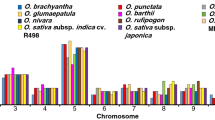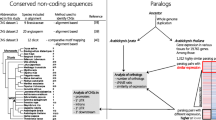Abstract
The Arabidopsis thaliana WRKY proteins are characterized by a sequence of 60 amino acids including WRKY domain. It is well established that these proteins are involved in the regulation of various physiological programs unique to plants including pathogen defense, senescence and response to environmental stresses, which attracts attention of the scientific community as to how this family might have evolved. We tried to satisfy this curiosity and analyze reasons for duplications of these gene sequences leading to their diversified gene actions. The WRKY sequences available in Arabidopsis thaliana were used to evaluate selection pressure following duplication events. A phylogenetic tree was constructed and the WRKY family was divided into five sub-families. After that, tests were conducted to decide whether positive or purified selection played key role in these events. Our results suggest that purifying selection played major role during the evolution of this family. Some amino acid changes were also detected in specific branches of phylogeny suggesting that relaxed constraints might also have contributed to functional divergence among sub-families. Sites relaxed from purifying selection were identified and mapped onto the structural and functional regions of the WRKY1 protein. These analyses will enhance our understanding of the precise role played by natural selection to create functional diversity in WRKY family.




Similar content being viewed by others
References
Altschul SF, Madden TL, Schaffer AA et al (1997) Gapped BLAST and PSI-BLAST: a new generation of protein database search programs. Nucleic Acids Res 25:3389–3402
Anisimova M, Bielawski JP, Yang Z (2002) Accuracy and power of bayes prediction of amino acid sites under positive selection. Mol Biol Evol 19:950–958
Asai T, Tena G, Plotnikova J et al (2002) MAP kinase signalling cascade in Arabidopsis innate immunity. Nature 415:977–983
Chen C, Chen Z (2000) Isolation and characterization of two pathogen- and salicylic acid-induced genes encoding WRKY DNA-binding proteins from tobacco. Plant Mol Biol 42:387–396
Chen JM, Cooper DN, Chuzhanova N et al (2007) Gene conversion: mechanisms, evolution and human disease. Nat Rev Genet 8:762–775
Church G, Sussman J, Kim S (1977) Secondary structural complementarity between DNA and proteins. Proc Natl Acad Sci 74:1458–1462
Crooks GE, Hon G, Chandonia JM et al (2004) WebLogo: a sequence logo generator. Genome Res 14:1188–1190
Dellagi A, Helibronn J, Avrova AO et al (2000) A potato gene encoding a WRKY-like transcription factor is induced in interactions with Erwinia carotovora subsp. atroseptica and Phytophthora infestans and is coregulated with class I endochitinase expression. Mol Plant Microbe Interact 13:1092–1101
Dong J, Chen C, Chen Z (2003) Expression profiles of the Arabidopsis WRKY gene superfamily during plant defense response. Plant Mol Biol 51:21–37
Du L, Chen Z (2000) Identification of genes encoding receptor-like protein kinases as possible targets of pathogen- and salicylic acid-induced WRKY DNA-binding proteins in Arabidopsis. Plant J 24:837–847
Duan M, Nan J, Liang Y et al (2007) DNA binding mechanism revealed by high resolution crystal structure of Arabidopsis thaliana WRKY1 protein. Nucleic Acids Res 35:1145
Edgar RC (2004) MUSCLE: a multiple sequence alignment method with reduced time and space complexity. BMC Bioinformatics 5:113
Eulgem T, Rushton P, Robatzek S et al (2000) The WRKY superfamily of plant transcription. Trends Plant Sci 5:199–205
Gu X (1999) Statistical methods for testing functional divergence after gene duplication. Mol Biol Evol 16:1664–1674
Gu X (2003) Functional divergence in protein (family) sequence evolution. Genetica 118:133–141
Gu X (2006) A simple statistical method for estimating type-II (cluster-specific) functional divergence of protein sequences. Mol Biol Evol 23:1937–1945
Gu X, Vander Velden K (2002) DIVERGE: phylogeny-based analysis for functional-structural divergence of a protein family. Bioinformatics 18:500–501
Ishiguro S, Nakamura K (1994) Characterization of a cDNA encoding a novel DNA-binding protein, SPF1, that recognizes SP8 sequences in the 5′ upstream regions of genes coding for sporamin and beta-amylase from sweet potato. Mol Gen Genet 244:563–571
Kalinina OV (2006) Amino acid residues that determine functional specificity of NADP- and NAD-dependent isocitrate and isopropylmalate dehydrogenases. Proteins Struct Funct Bioinforma 64(4):1001–1009
Kalinina OV, Novichkov PS, Mironov AA et al (2004) SDPpred: a tool for prediction of amino acid residues that determine differences in functional specificity of homologous proteins. Nucleic Acids Res 32:W424–W428
Maeo K, Hayashi S, Kojima-suzuki H et al (2001) Role of conserved residues of the WRKY domain in the DNA-binding of tobacco WRKY family proteins. Biosci Biotechnol Biochem 65:2428–2436
Nielsen R, Yang Z (1998) Likelihood models for detecting positively selected amino acid sites and applications to the HIV-1 envelope gene. Genetics 148:929–936
Pei J, Cai W, Kinch L et al (2006) Prediction of functional specificity determinants from protein sequences using log-likelihood ratios. Bioinformatics 22:164
Posada D (2002) Evaluation of methods for detecting recombination from DNA sequences: empirical data. Mol Biol Evol 19:708–717
Posada D, Crandall KA (1998) MODELTEST: testing the model of DNA substitution. Bioinformatics 14:817–818
Ronquist F, Huelsenbeck JP (2003) MrBayes 3: Bayesian phylogenetic inference under mixed models. Bioinformatics 19:1572–1574
Rushton PJ, Macdonald H, Huttly AK et al (1995) Members of a new family of DNA-binding proteins bind to a conserved cis-element in the promoters of alpha-Amy2 genes. Plant Mol Biol 29:691–702
Sawyer S (1989) Statistical tests for detecting gene conversion. Mol Biol Evol 6:526–538
Suyama M, Torrents D, Bork P (2006) PAL2NAL: robust conversion of protein sequence alignments into the corresponding codon alignments. Nucleic Acids Res 34:W609–W612
Sywula T (1989) Gene conversion as a possible factor influencing genetic polymorphism. Hereditas 111:171–174
Wang M, Zhang X, Zhao H et al (2009) FoxO gene family evolution in vertebrates. BMC Evol Biol 9:222
Wong WS, Yang Z, Goldman N et al (2004) Accuracy and power of statistical methods for detecting adaptive evolution in protein coding sequences and for identifying positively selected sites. Genetics 168:1041–1051
Wu K, Guo Z, Wang H et al (2005) The WRKY family of transcription factors in rice and Arabidopsis and their origins. DNA Res 12:9
Yang Z (1998) Likelihood ratio tests for detecting positive selection and application to primate lysozyme evolution. Mol Biol Evol 15:568–573
Yang Z (2002) Likelihood and Bayes estimation of ancestral population sizes in hominoids using data from multiple loci. Genetics 162:1811–1823
Yang Z (2007) PAML 4: phylogenetic analysis by maximum likelihood. Mol Biol Evol 24:1586–1591
Yang Z, Nielsen R (2002) Codon-substitution models for detecting molecular adaptation at individual sites along specific lineages. Mol Biol Evol 19:908–917
Yuan Z, Bailey T, Teasdale R (2005) Prediction of protein B-factor profiles. Proteins Struct Function Bioinformatics 58:905–912
Zhang J, Nielsen R, Yang Z (2005) Evaluation of an improved branch-site likelihood method for detecting positive selection at the molecular level. Mol Biol Evol 22:2472–2479
Acknowledgments
The authors are grateful to the editor and the anonymous reviewers for their suggestions and comments, which have greatly improved the paper. This work was supported by the National Natural Science Foundation of China (grant no. 31000992, 31072003, 30871782) and the National High Technology Research and Development Program of China (863 project) (grant no. 2008AA101002).
Author information
Authors and Affiliations
Corresponding author
Electronic supplementary material
Below is the link to the electronic supplementary material.
Rights and permissions
About this article
Cite this article
Wang, Q., Wang, M., Zhang, X. et al. WRKY gene family evolution in Arabidopsis thaliana . Genetica 139, 973–983 (2011). https://doi.org/10.1007/s10709-011-9599-4
Received:
Accepted:
Published:
Issue Date:
DOI: https://doi.org/10.1007/s10709-011-9599-4




